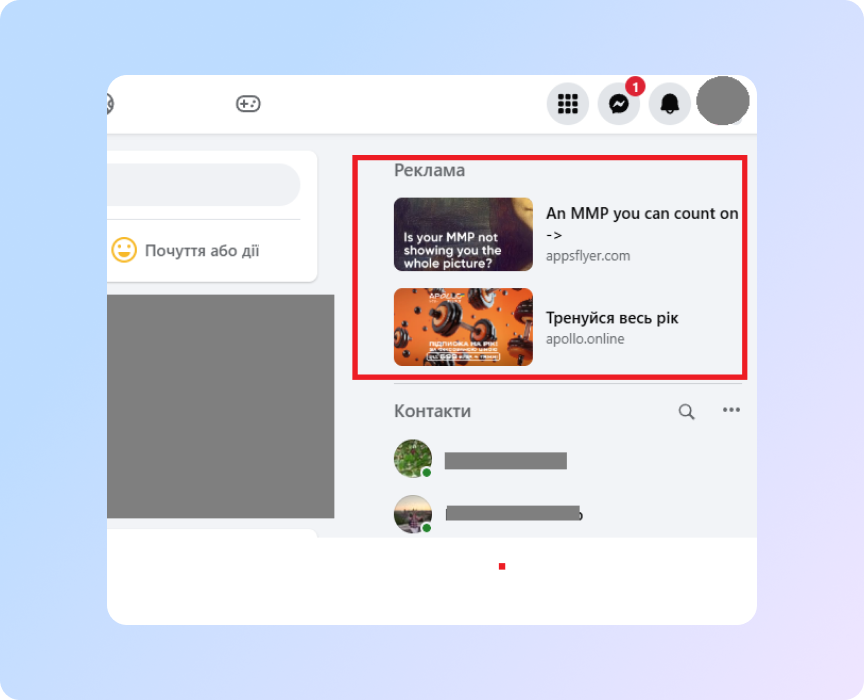No magic - just our painstaking joint work on the site
What Is Targeted Advertising, What Types Exist, and How Does It Work?
Targeted advertising is a versatile tool for promoting products, services, personal brands, and business profiles on social media. Unlike contextual advertising, which appears in search results based on relevant queries, targeted ads are customized according to specific user parameters.
In this article, we’ll break down what this is and how targeted advertising works, its key features and benefits, and where it’s most effective. We’ll also explore how ads appear on different social media platforms, which businesses can benefit from this format, and share some tips for running successful campaigns.
How Targeted Advertising Works
When users create social media accounts, they provide certain personal details, such as their date of birth, education, or workplace. At the same time, social media algorithms track the devices they use, their location data, and their interests — such as posts they engage with, pages they follow, and groups they join.
When launching a traffic or sales-focused campaign, an advertiser:
- Configures audience targeting settings in the chosen social media platform’s ad manager.
- Creates an ad by writing copy and designing visual content.
- Sets a budget and launches the ad campaign.
Ads are displayed only to users who match the specified targeting criteria.
How Targeted Ads Appear
Targeted advertising in social networks is shown:
- in the feed. Such ads are very similar to a regular publication and contain the "Advertisement" mark;
- in the sides;
- near the recommended ones;
- in the left or right column of the screen - on the desktop.
To grab the user’s attention, an ad must be visually appealing and relevant to the target audience. Feed ads are more likely to be effective if they look natural and non-intrusive.
Advantages and Challenges of Targeted Advertising
Targeted advertising has several key benefits as a marketing tool:
- Wide reach. People of all ages, interests, and financial backgrounds have social media profiles, making it easy to connect with diverse audiences.
- Precise targeting. Advertisers can easily set up campaigns to reach users that match specific criteria.
- Personalized offers. Audience segmentation allows advertisers to maximize ad effectiveness. Tailored creatives and formats address specific needs and pain points of different customer groups.
- Great potential for new businesses. Targeted ads are particularly useful for businesses and content creators that don’t yet have a large follower base or an established online presence.
- Easy strategy adjustments. Targeting tools enable advertisers to continuously monitor campaign performance, test hypotheses, optimize ad delivery settings, and manage budget allocation.
However, businesses should be aware that social media users primarily log in for entertainment and information, not necessarily to make purchases. As a result, conversion rates may not always be high. Additionally, each platform has specific requirements for ad text and images, as well as a moderation process that ads must pass before going live.
Who Can Benefit from Social Media Targeting?
Targeted advertising can be used to promote any type of business — both B2C and B2B — across a wide range of products, services, and digital programs. Whether marketing to a broad audience or a niche group, this tool is effective at various stages of the sales funnel. The choice of strategy depends on business objectives, the complexity of the offering, and the available ad budget.
Types and Formats of Targeting
Targeted advertising is categorized based on its key characteristics and falls into five main types:
- Demographic targeting – Uses age, gender, ethnicity, education, and income level to refine the audience.
- Geotargeting – Focuses on a user’s location, such as country, region, city, or even specific neighborhoods.
- Interest-based targeting – Displays ads to users who engage with specific topics, such as fitness, automobiles, or travel.
- Behavioral targeting – Uses past user activity (e.g., website visits, link clicks, and social media follows) to determine relevant ads.
- Time-based targeting – Allows advertisers to schedule ads for specific time frames when engagement is expected to be highest.
Targeted ads can be displayed in various formats, including:
- Posts – Standard posts or carousel posts, allowing users to swipe through multiple offers.
- Stories – Short-lived, full-screen ads that blend naturally with user-generated content.
- Video ads – Engaging video-based promotions that capture user attention.
- Slideshow ads – A sequence of images with background music, creating a video-like effect.
- Lead Ads – A combination of an ad and a built-in form for collecting user contact information.
Retargeting is a specific type of targeted advertising that shows ads to users who have previously visited the advertiser’s website or social media page. This strategy helps re-engage potential customers who have already expressed interest in the brand.
Targeted Advertising on Different Social Media Platforms
Now that you have a basic understanding of targeted advertising on Instagram, Facebook, and YouTube, let’s break down which platform is best suited for different audiences.
Facebook has the highest conversion rates among social media platforms. Its audience is generally older and often financially stable, making it ideal for promoting medical, legal, financial, and travel services, as well as online courses and mass-market products. To run ads, businesses need a Facebook Business Account, and campaigns are managed through Facebook Ads Manager.
Instagram’s targeted advertising works best for products and services where visuals play a key role, such as fashion, beauty, food, and home decor. It’s also effective for showcasing the results of professional services (e.g., fitness training, interior design). Campaigns can be launched from a professional Instagram account or through Facebook Ads Manager.
YouTube ads are particularly effective for middle-aged and older audiences. The platform’s ad settings allow advertisers to define their target audience with a high level of precision. Video ads on YouTube can be used for branding, product demonstrations, and educational content.
What Goals Does Targeted Advertising Achieve?
Social media targeting is used for:
- Driving traffic to a website and increasing sales.
- Promoting posts and growing follower count.
- Attracting online users to offline businesses (e.g., for beauty clinics).
- Boosting brand awareness.
Targeted advertising is especially effective for introducing a new product to an audience. Unlike contextual advertising, which primarily targets "warm" leads already interested in a product or service, targeting also reaches "cold" audiences who may not yet be familiar with the brand.
How Much Does Targeted Advertising Cost?
The most common pricing models include:
- CPC (Cost Per Click) – Payment for each user click on the ad.
- CPM (Cost Per Mille) – Payment per 1,000 ad impressions.
Other possible pricing models:
- CAC (Customer Acquisition Cost) – The cost of acquiring one customer.
- CPA (Cost Per Action) – The price per specific user action (e.g., sign-up, purchase).
- CPI, CPF, CPO, CPL, CPV – Costs per app installation, new follower, completed order, lead generation, and video view, respectively.
How to Measure the Effectiveness of Targeted Advertising
To evaluate campaign performance, advertisers track the following metrics:
- Total reach statistics – How many users saw the ad.
- Audience growth – The increase in followers or subscribers.
- Lead generation – The number of potential customers acquired through ads.
- Traffic and conversion rates – The number of clicks and their cost per visit to a website or social media profile.
Regular monitoring of these metrics allows for timely adjustments in ad formats, creatives, audience targeting, and budget allocation.
Expert Tips
Common mistakes in targeted advertising include a lack of audience segmentation, mixing "warm" and "cold" audiences, and adding unnecessary targeting filters that limit potential reach. To achieve the best results:
- Define your target audience as precisely as possible. Avoid using multiple types of targeting simultaneously, as this can reduce ad effectiveness.
- Set clear advertising goals before launching campaigns.
- Experiment with creatives and ad formats until you find the most effective combination for your audience.
- Start with a minimal budget and gradually increase spending as you refine your targeting strategy.
- Get a Free Targeting Consultation with Sprava Agency.
Boost your social media reach and attract more customers — book a free consultation with Sprava Agency today!
We care about improving your sales :)

































